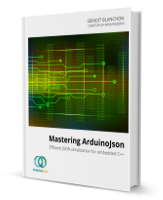StringExample.ino
Description
This example shows the different ways you can use String with ArduinoJson.
Use String objects sparingly, because ArduinoJson duplicates them in the JsonDocument.
Source code
#include <ArduinoJson.h>
void setup() {
DynamicJsonDocument doc(1024);
// You can use a String as your JSON input.
// WARNING: the string in the input will be duplicated in the JsonDocument.
String input =
"{\"sensor\":\"gps\",\"time\":1351824120,\"data\":[48.756080,2.302038]}";
deserializeJson(doc, input);
JsonObject obj = doc.as<JsonObject>();
// You can use a String to get an element of a JsonObject
// No duplication is done.
long time = obj[String("time")];
// You can use a String to set an element of a JsonObject
// WARNING: the content of the String will be duplicated in the JsonDocument.
obj[String("time")] = time;
// You can get a String from a JsonObject or JsonArray:
// No duplication is done, at least not in the JsonDocument.
String sensor = obj["sensor"];
// Unfortunately, the following doesn't work (issue #118):
// sensor = obj["sensor"]; // <- error "ambiguous overload for 'operator='"
// As a workaround, you need to replace by:
sensor = obj["sensor"].as<String>();
// You can set a String to a JsonObject or JsonArray:
// WARNING: the content of the String will be duplicated in the JsonDocument.
obj["sensor"] = sensor;
// It works with serialized() too:
obj["sensor"] = serialized(sensor);
// You can also concatenate strings
// WARNING: the content of the String will be duplicated in the JsonDocument.
obj[String("sen") + "sor"] = String("gp") + "s";
// You can compare the content of a JsonObject with a String
if (obj["sensor"] == sensor) {
// ...
}
// Lastly, you can print the resulting JSON to a String
String output;
serializeJson(doc, output);
}
void loop() {
// not used in this example
}
Classes used in this example
Functions used in this example
See also
Keep learning
Mastering ArduinoJson begins with a quick C++ course that explains how your microcontroller stores strings in memory, so you can perfectly understand what happens behind the scenes.
The chapter “Inside ArduinoJson” explains what a JsonDocument is and why it is essential for the performance of the library. This chapter also describes how StaticJsonDocument and DynamicJsonDocument work, and how to choose between them.

